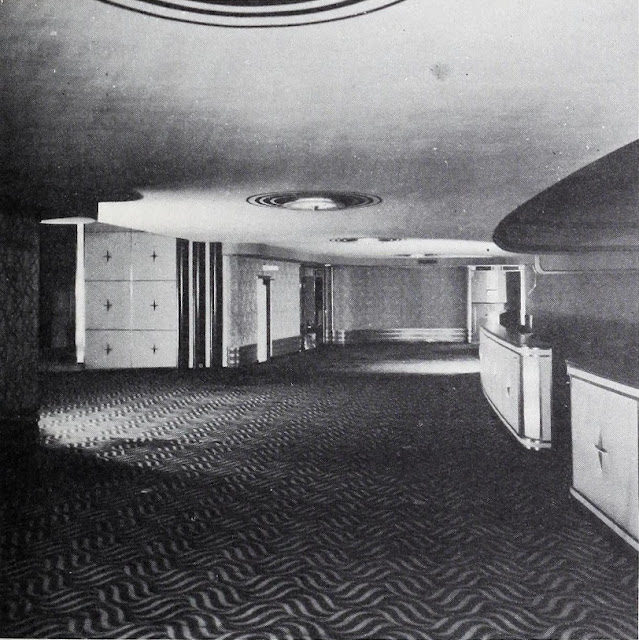The Exhibitor, September 20, 1939:
"That Baltimore might have its branches of the world's two most popular forms of entertainment, radio and motion pictures, combined under one roof, and in a setting conducive to both, Morris A. Mechanic, Baltimore exhibitor, retained Armand Carroll, Philadelphia architect to design a suitable structure."
"The front with its majestic upright sign is indeed a credit to its designer. Travertine and black Virginia stone were used here with striking results. The upright sign and marquee are of porcelain enamel constructed with stainless steel trim."
Station WFBR
"Radio station WFBR, which occupies the second floor of the theatre building, is said to be the most modern station in the country. Its six studios include exceptional facilities for accommodating large audiences for local shows."
Centre Theatre
"The Facade as it appears from a more central point. From this view is gained a better perspective of the overall design. The black stone portion which extends out from the face of the building allows a space directly in front of the radio station windows for potted shrubbery."
"The inside lobby which leads into the standee room is without furnishings. Its most prominent feature is the large mural done on green linoleum. This mural is indirectly lighted from a trough immediately behind."
"The standee room is well carpeted in a standard Crestwood pattern of black and gold. The standee railing has been covered with padded natural pigskin leather ornamented with bronze stars, and molding. Aisles are of luminous glass and are back lighted ."
"The proscenium design is a definite departure from the usual formula. A perfect circle, it is broken only by the upper side walls of asbestos transite, which flows gracefully into it. The lower portion of the walls have been covered with green and gold damask and have grained walnut plywood as a wainscot. The curved ceiling, with a number of small direct lighting fixtures supplemented by coves for indirect illumination, is of hard white plaster and painted in a shade of ecru."
Since 1997 theatre historian, Cezar Del Valle, has conducted a popular series of theatre talks and walks, available for historical societies, libraries, senior centers, etc.
Del Valle is the author of the Brooklyn Theatre Index, a three-volume history of borough theatres.
The first two chosen 2010 OUTSTANDING BOOK OF THE YEAR by the Theatre Historical Society. Final volume published in September 2014.
Currently seeking funding for “Editing & Formatting” the first three volumes of the Brooklyn Theatre Index, 3rd Edition






No comments:
Post a Comment